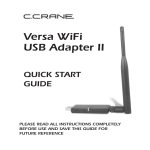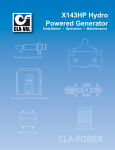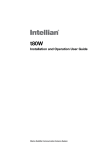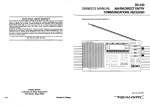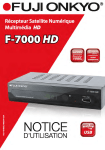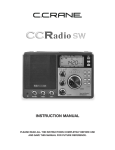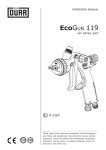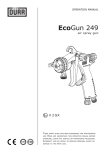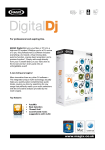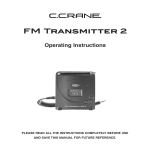Download C. Crane 024 S Instruction manual
Transcript
Pocket Radio
INSTRUCTION MANUAL
PLEASE READ ALL THE INSTRUCTIONS
COMPLETELY BEFORE USE
AND SAVE THIS MANUAL
FOR FUTURE REFERENCE.
Ꮨ
Before Use
Please read IMPORTANT SAFETY
INSTRUCTIONS on pages 23-25 before
use. It is important to read and understand
all instructions. Keep these precautions
and instructions where all who use this
radio will read them.
WARNING: TO PREVENT FIRE OR ELECTRIC SHOCK HAZARD, DO NOT EXPOSE
THIS PRODUCT TO RAIN OR MOISTURE.
CAUTION
RISK OF ELECTRIC
SHOCK DO NOT OPEN
CAUTION: TO REDUCE THE RISK OF ELECTRIC SHOCK, DO NOT REMOVE THE RADIO
BACK. NO USER SERVICEABLE PARTS
INSIDE. REFER SERVICING TO QUALIFIED
SERVICE PERSONNEL.
Ꮨ
THE LIGHTNING FLASH AND ARROWHEAD WITHIN THE TRIANGLE IS A
WARNING SIGN ALERTING YOU OF
“DANGEROUS VOLTAGE” INSIDE THE
RADIO.
THE EXCLAMATION POINT WITHIN
THE TRIANGLE IS A WARNING SIGN
ALERTING YOU OF IMPORTANT
INSTRUCTIONS ACCOMPANYING
THIS RADIO.
For your future reference:
Serial No.
(found inside battery compartment)
Date of Purchase
Name & Address of Dealer
Unpacking
The box should contain the CC SW Pocket,
carry pouch and this manual. If anything is
missing or damaged, please contact your dealer
immediately. We recommend you keep the box
in the unlikely event your radio needs to be
serviced.
Copyright © 2007-2011 by
C. Crane Company, Inc.
1001 Main St, Fortuna, CA 95540
Phone: 1-800-522-8863
Web: ccrane.com
All rights reserved. No part of this booklet may
be reproduced, in any form or means whatsoever,
without permission in writing from
C. Crane Company, Inc.
CC SW Pocket
Page 3
Quick Start
1. Slide K (pg. 10) “SENSITIVITY”
switch to “DX” position.
2. Install two AA batteries in the g
battery compartment, paying close
attention to orientation of the batteriesʼ + and – ends.
3. Turn on the radio by pressing the
Q POWER button.
4. Adjust Y “VOLUME”
5. Select band by pressing the O
BAND button
6. Use the W “TUNING” knob to
locate a station or by directly
entering a frequency:
a) First, select the O BAND you
want
b) press the P “FREQ” UENCY”
button
c) Enter the frequency on the
{ keyboard.
Page 4
CC SW Pocket
Table of Contents
Unpacking ............................................... 3
Quick Start ............................................... 4
Radio Identification ........................... 6-11
Features and Operation Explained
Introduction ............................ 12
Power Sleep Button ............... 12
Tuning Knob ........................... 13
Light ........................................ 14
Display Button ..................... 14
Setting the Alarm .................. 15
Up and Down Buttons ........... 16
Band Button .......................... 16
Frequency Button .................. 16
0-9 Keys ................................. 17
Setting Clock Time ................ 18
Saving Stations to Memory ... 18
Favorites ................................ 19
Performance Tips ........................... 19-20
Troubleshooting Guide .......................... 21
Specifications ......................................... 22
Power Adapter ...................................... 22
Safety Instructions ........................... 23-25
Shortwave Tips ................................. 26-27
Station Log ........................................ 28-31
CC SW Pocket
Page 5
Page 6
CC SW Pocket
{ P
}
O
Radio Identification — Front View
I
q w
U
Y
R
T
E
W
Q
CC SW Pocket
DISPLAY, Time, Frequency,
Alarm, AM Step, 12/24 Hour
LIGHT Button
TUNING Knob
POWER and SLEEP Timer
, Frequency, Time,
Memory Tune
Y
U UP
Set Alarm Time
VOLUME, Up and Down
T ALARM, (De)Activate Alarm,
Q
W
E
R
Memory Tune
I DOWN , Frequency, Time,
<
>
Page 7
Memories only
} LCD Display
q MEMORY, TIME SET Button
w FAVORITES, Tune
and Memory access
{ 0-9 KEYS, Direct Frequency
Frequency
• 9-10 kHz steps
P “FREQ” UENCY, Press to enter
O BAND, Change Bands,
Page 8
CC SW Pocket
G
H
J
F
e r
D
S
t y u i o
Radio Identification — LCD Display
[
A ]
p
CC SW Pocket
Page 9
[
o
p
i
t
y
u
r
only when headphones are used
TUNE indicator means a
station or noise is high
SLEEP FUNCTION indicator
AL means alarm is active
AUTO, Radio alarm or goes to
Buzzer, if radio is already “on”
BUZZER
indicates buzzer
type alarm
LOCK switch is “on”
M.SCAN (FAVORITES), tunes
memorized stations only
Indicates memory channel number 00-199 for Memory Stations
e FM STEREO indicator, displays
are low
H FM indicates radio is in FM band
J BATTERY flashing indicates batteries
(medium wave)
G MW indicates “AM” in U.S.
or Shortwave II
F SWI or SWII, indicates Shortwave I
time format
and SW bands only
A MHz indicates Megahertz in FM band
S Time or Frequency display
D AM/PM show while in 12 hour
] kHz indicates Kilohertz while in AM
Radio Identification — Sides
a
K
L
s
:
d
K DX - LOCAL switches Sensitivity of SW
and FM bands
L EARPHONE jack
: DC Power Jack, 3 Volts, Tip Negative
a TUNING KNOB adjusts Frequency,
Time, Presets
s BASS - NORMAL Switch, select for
best sound
d LOCK, press to lock, hold for 1 second
to unlock
Page 10
CC SW Pocket
Radio Identification — Back
f
h
g
f WHIP ANTENNA used for FM and
SW bands
g BATTERY COMPARTMENT
LOCATION, insert 2 “AA” batteries
h RESET HOLE for resetting radio
(located on bottom of radio)
CC SW Pocket
Page 11
Features and Operation Explained
Introduction
The CC SW Pocket is the perfect size for
packing around. It is unusually good at picking up stations. Audio is clear for its size,
while taking as long as 70 hours to wear
down a set of two AA batteries. Using the
Tuning knob can be wearisome as it is with
any small radio. The SWP has a novel way
to zip around the bands to your favorite stations. “FAVORITES” (Memory Scan) can be
used to quickly access all of your AM/FM and
SW stations rapidly and across bands without pressing buttons. We encourage you to
learn how to memorize a station (page 18).
You can then use the “FAVORITES” button
and the Tuning Knob to quickly scan your
memory presets.
Q
POWER • SLEEP Button
When you press and release the “POWER”
button the first time, you will see “on” displayed for about two seconds. Press the
“POWER” button again to turn the radio off.
To change to a “SLEEP” setting, press
“POWER” again during the short time the
“on” is displayed. It will first show “90” minutes and then decrease by five minutes for
Page 12
CC SW Pocket
Features and Operation Explained
each successive press. You have a choice of
“on”, and from 90 minutes down to 5 minutes
by 5-minute steps. Stop on the setting you
desire and it will be remembered for your
convenience each time you turn the radio
“on” again. If you select any one of the sleep
settings, except “on”, the SLEEP symbol
will be displayed while the radio is “on”.
When “on” is selected, the radio will simply
turn on and off each time the power button is
pushed.
Pressing the “POWER • SLEEP” button while
the radio is operating on any of the SLEEP
settings will turn the radio off.
W
TUNING KNOB
Turn the Tuning Knob while the radio is on to
tune to a different frequency.
When setting the clock or alarm, it is also a
good way to change the time, rather then
using the up and down buttons.
The Tuning Knob also works when you have
your favorite stations in memory. You can
press “FAVORITES” and use the tuning knob
to quickly access your memorized station.
See page 19 for w “FAVORITES”.
CC SW Pocket
Page 13
Features and Operation Explained
E
LIGHT
Pressing the “LIGHT” button will give you
about eight seconds of light on the display.
R DISPLAY button
The DISPLAY button works in two ways:
1. When the radio is “on” the LCD display
normally shows the frequency. Pressing
the “DISPLAY” button will toggle the display through “ALARM TIME”, “TIME” of
day, and “SLEEP” timer status. It will show
the minutes left on the “SLEEP” timer or
“on” if the sleep timer is not being used.
2. When the radio is “off” the LCD display
normally shows the time of day. Pressing
the “DISPLAY” button will toggle the display through “ALARM TIME”, tuning steps
for AM, and your choice of 12 or 24 hour
clock format. While the radio is “off”, you
can change from 12 hour to 24 hour clock
format by holding the “DISPLAY” button
for five seconds. Change it back using the
same method. See O “BAND” button on
page 16 to change tuning steps for AM.
Page 14
CC SW Pocket
Features and Operation Explained
T
SETTING THE ALARM
You can activate or deactivate the alarm if
the radio is “on” or “off”. Pushing the
“ALARM” button once sets the alarm to
and the “radio” alarm. (The radio will
alarm on the last station listened to.) A second push of the “ALARM” button sets the
alarm to “buzzer” . A third press of the
“ALARM” button turns off both icons and the
radio will not alarm. Press the “Power” button
to stop the alarms when they come on. The
alarm will not work if headphones are
plugged in.
Set the alarm time with the radio “off”.
Press and hold the “ALARM” button for two
seconds. Use the Tuning Knob to set the
hours, press the “ALARM” button again and
set the minutes. You must press the
“ALARM” button again when done to confirm
the “ALARM” time.
If the alarm is set to “AUTO” and you happen
to have the radio “on” at the alarm time, then
the buzzer will automatically come on, too.
Y VOLUME
This is easy, up + and down -.
CC SW Pocket
Page 15
UP
O
BAND button
<
U
and
I DOWN
<
Features and Operation Explained
Buttons
These buttons can be used to tune the radio
one step at a time or “press and hold” to
scan for the next strong station.
The buttons can also be used when setting
the time or to scroll through memorized stations while in w FAVORITES (Memory
Scan) mode.
Pressing the “BAND” button with the radio
“on” changes bands in order: FM, AM, SW1,
and SW2.
With the radio “off”, the “BAND” button can
be pressed and held for five seconds to
change the AM tuning steps from 10 to 9
kHz. The U.S. uses 10 kHz. Most of the rest
of the world uses 9 kHz steps. It could be
important to change the AM step rate if you
use the “Up” and “Down” button to scan for
stations and you happen to be in a foreign
country.
P “FREQ”UENCY Button
This is used to directly enter a frequency.
You must be in the radio band of your choice
before you enter a frequency. AM and SW is
Page 16
CC SW Pocket
Features and Operation Explained
straightforward. Press “FREQ” and enter the
AM or SW frequency using the numbered
keys. For FM you must enter a last digit. To
enter 100.3 FM you must press “FREQ” and
then press 1-0-0-3.
{ 0-9 KEYS
These are used to directly enter a frequency
or memory channel. See P “FREQ”UENCY
button for direct entry.
While in w FAVORITES (Memory Scan)
mode you can also enter the channel number
of a station you memorized. There is a programming quirk, however. Because there are
200 channels, you must key in 3 digits for
each number. Channel “00” through “9” must
be entered with a “00” in front of the channel
number. Channel numbers 10 through 19
must have a “0” entered in front of the channel number. Example: Channel “1” must be
entered as 0-0-1.
} LCD DISPLAY
Learning the features and the corresponding
display icons can make your radio easier to
use.
CC SW Pocket
Page 17
Features and Operation Explained
q
SETTING CLOCK TIME /
SAVING A STATION TO MEMORY
The Memory/Time SET key works in two
ways:
1. Setting the Clock:
When the radio is “off” press and hold
for one second until “Hour” flashes. You
have eight seconds to set the hour. Use
either the Tuning Knob or “UP” and
“DOWN” buttons. Press again to set the
minutes. Press a third time to confirm
when done. You can change from 12 hour
to 24 hour clock format by holding the
“DISPLAY” button for five seconds.
2. Saving a Station:
When the radio is “on” the key is used to
store a station into memory. First, tune to
a station or frequency you want. Press
“MEM T.SET and
will blink in the
upper right corner of the LCD display.
Rotate the Tuning Knob to the memory
channel where you want to store the station. The memory channels are numbered
from “00” to “199”. Press “MEM T.SET”
again to finalize the memorized station.
There is a log in the back of this manual
on pages 28-31 to help you organize your
Page 18
CC SW Pocket
Features and Operation Explained
stations. Your memories will not be lost
when batteries go dead or if you reset the
radio.
w
FAVORITES (Recalling Saved Stations)
Pressing the “FAVORITES” key allows you to
tune the stations you have previously saved
in memory. You can use the Tuning Knob,
“Up” and “Down” buttons, or 0-9 Keys to go
from one saved station to another. This can
save you much time if you are familiar with
the stations in your area. There is no other
function to this button. Press “FAVORITES”
again to go back to regular tuning.
Performance Tips
While excellent for fine tuning, the Tuning
Knob moves in only 1 kHz steps. Using the
FAVORITES (Memory Scan) to dial right to
your stations is a fast and easy method
(above). You also have the ability to directly
enter a frequency. See Shortwave Tips on
page 26.
For best AM reception, rotate the radio for
the clearest audio. If radio noise is present,
try moving the radio to a better location so
the noise decreases. Many times this is only
CC SW Pocket
Page 19
Performance Tips
a few inches or feet away. In a hotel room, try
putting it in a window sill.
For FM, the telescopic antenna “up full” usually gives best reception. The antenna can
also be rotated and shortened until the best
signal is received.
Always fully extend the telescopic antenna for
the best Shortwave reception. SW reception
can easily be improved with the addition of a
very simple antenna. A portable SW antenna
available from C. Crane works well for travel.
Also, any insulated small diameter wire can
be wound around the whip antenna and
extended out 20' to 60'. The wire can be
mounted on the inside of an outside wall or
out a window and along the top of a nonmetal fence. Simple experimentation with the
antenna wire location is the best way.
Most of the time, leave the DX-LOCAL switch
set on DX, unless you are receiving an overly
strong station. This can keep the strong station from overdriving the radio and also help
in listening to a weaker station that is next to
a strong station.
The buttons can be somewhat hard to press.
Check the LCD display to confirm that you
have pressed it hard enough to register.
Page 20
CC SW Pocket
Troubleshooting Guide
This radio has a microprocessor. If the display disappears or has odd characters, try
resetting the radio. Use a toothpick or paperclip to momentarily stick in the “reset” hole
gently. It is located on the bottom of the
radio. The radio can be “on” or “off” when
this is done. There must be power to the
radio either by AC Adapter or batteries.
NO AUDIO: Be sure the volume is up and
headphone jack does not have something in
it. The alarm will not work if headphones are
plugged in.
RADIO WILL NOT COME ON: Be sure the
“LOCK” switch is off. Press and hold for one
second to turn “LOCK” off.
BATTERIES: Do not mix old batteries with
new batteries. The battery icon
flashes
when the batteries are low. You have 15 seconds to change a set of batteries or you may
have to set the clock time again.
AC ADAPTER: Make sure it is fully plugged
into the radio.
SENSITIVITY: Be sure DX-LOCAL switch is
on “DX”. DX is an abbreviation for “distance”.
Be sure the antenna is up fully for FM and
SW.
CC SW Pocket
Page 21
Specifications
1. Frequency Coverage:
FM
70.0 ~ 108.0MHz
AM (MW) 522 ~ 1628kHz (9k step)
520 ~ 1710kHz (10k step)
SW1
2300 ~ 7500kHz
SW2
9200 ~ 22000kHz
2. S/N (Signal to Noise) Sensitivity:
FM
> 10uV
AM
> 1mv/m (this is extraordinary)
SW
> 30uV
3. AM Selectivity: > 25dB
4. Number of Memories: 200
5. Power Source:
2 (AA Size) or LR2
DC IN: 3V 200mA, Tip (-) 3.5mm x 1.3mm
6. Built-in Speaker: 25ohm 0.5W
7. Earphone Socket: 3.5mm 32ohm
8. Dimensions: 4.75" W x 3" H x 1.2" D
Power Adapter
If you have purchased an optional AC-DC
adapter, be sure it is the correct voltage. It
should have an output of three Volts DC with the
center negative, and not less than 100 mA. Use
only the recommended adapter. Otherwise it
may damage the radio or cause a fire or electric
shock.
Page 22
CC SW Pocket
Safety Instructions
Ꮨ
READ BEFORE
OPERATING EQUIPMENT
SAVE THESE INSTRUCTIONS
To prevent damage to your radio or possible
injury to you or others, read these safety precautions and instructions entirely before
applying power to your radio. Keep these
precautions and instructions where all who
use this radio will read them.
1) COMMON CARE
Check the radio, AC adapter, batteries
and any accessories regularly. Do not use
the radio if there is any sign of damage.
Only operate in accordance with the instructions in this manual. Only use attachments or accessories specified by the
manufacturer.
2) PROPER BATTERY HANDLING
Never mix different type of batteries or
use old batteries with new. We recommend you remove batteries from the radio
if you are not going to use the radio for
one month or more.
3) DISCONNECT THE RADIO
IN CASE OF MALFUNCTION
If you smell or notice smoke, disconnect
CC SW Pocket
Page 23
Safety Instructions
the AC Adapter and remove the batteries
immediately, taking care to avoid burns.
Contact C. Crane Company or their representative for inspection and service
before any future operation. Only use
the AC-DC Adapter recommended with
the unit and replace it if wires become
frayed or exposed. It should have an
output of three Volts DC with the center
negative, and not less than 100mA. Use
only the recommended adapter. Otherwise
it may damage the radio or cause a fire or
electric shock.
4) KEEP OUT OF REACH
OF CHILDREN
Dropping the radio can cause damage or
injury. Keep the AC Adapter cord in a
position so someone cannot trip and
cause the radio to fall.
5) KEEP AWAY FROM WATER
AND MOISTURE
Keep the radio dry. Liquids and moisture
can damage the radio. If a liquid leaks into
the radio do not operate and seek a qualified service shop. To clean the radio,
remove the power and use a clean, soft
damp cloth on the exterior only.
Page 24
CC SW Pocket
Safety Instructions
6) KEEP AWAY FROM
EXTREME TEMPERATURES
Extreme temperatures can damage the
radio. Do not leave or use the radio where
it can be subjected to high or very cold
temperatures.
7) DO NOT ATTEMPT TO
SERVICE RADIO
Refer all service work to a qualified
service shop when the radio does not
appear to operate normally, exhibits a
change in performance or the radio has
received damage. Never open the radio
as this may expose you to dangerous
voltages and this will void all warranties.
8) OUTSIDE ANTENNAS
OR CABLES
Outside antennas or cables that create a
potential hazard should not be used with
this radio unless installed by qualified
personnel.
CC SW Pocket
Page 25
Shortwave Tips
The CC SW Pocket covers all of the important international broadcast bands. A “ * ”
symbol signifies where you most likely find
the best listening. They are listed by frequency and then the (meter band). There are
exceptions to every rule in Shortwave.
Reception will vary when you are in a foreign
country.
The CC SW Pocket has plenty of memory. If
you install active frequencies into memory,
you can recall them easily. When you are trying to find a station, it is best to switch to
manual tuning, using the tuning knob.
SWI
2300~2495 kHz (120m) –
mostly tropical regions
3200~3400 kHz (90m) –
mostly tropical regions
3900~4050 kHz (75m) –
mostly Europe
4400~5100 kHz (60m) –
night, mostly tropical
5800~6300 kHz (49m) –
all year-round, night
7100~7600 kHz (41m) –
best at night
Page 26
CC SW Pocket
Shortwave Tips
SWII
9250~9995 kHz (31m) –
all year, night/winter *
11.50~12.16 MHz (25m) –
summer; near sunset
13.57~13.87 MHz (22m) –
day and summer
15.00~15.825 MHz (19m) –
day and summer *
17.48~17.90 MHz (16m) –
day and summer
18.90~19.02 MHz (15m) –
day, not much
21.45~21.85 MHz (13m) –
day, not much
Shortwave broadcasters use Universal Time
Coordinated (UTC) time to coordinate their
shows. You can normally find a UTC time
signal at 5,000, 10,000 or 15,000 kHz.
CC SW Pocket
Page 27
Station Log
000
001
002
003
004
005
006
007
008
009
010
011
012
013
014
015
016
017
018
019
020
021
022
023
024
025
026
027
028
029
030
031
032
033
034
035
036
037
038
039
040
041
042
043
044
045
046
047
048
049
Log Pages may be copied for your use. C. Crane
Page 28
CC SW Pocket
Station Log
050
051
052
053
054
055
056
057
058
059
060
061
062
063
064
065
066
067
068
069
070
071
072
073
074
075
076
077
078
079
080
081
082
083
084
085
086
087
088
089
090
091
092
093
094
095
096
097
098
099
Log Pages may be copied for your use. C. Crane
CC SW Pocket
Page 29
Station Log
100
101
102
103
104
105
106
107
108
109
110
111
112
113
114
115
116
117
118
119
120
121
122
123
124
125
126
127
128
129
130
131
132
133
134
135
136
137
138
139
140
141
142
143
144
145
146
147
148
149
Log Pages may be copied for your use. C. Crane
Page 30
CC SW Pocket
Station Log
150
151
152
153
154
155
156
157
158
159
160
161
162
163
164
165
166
167
168
169
170
171
172
173
174
175
176
177
178
179
180
181
182
183
184
185
186
187
188
189
190
191
192
193
194
195
196
197
198
199
Log Pages may be copied for your use. C. Crane
CC SW Pocket
Page 31
Model: CC SW Pocket
ANSI C63.4: 2003
THIS DEVICE COMPLIES WITH PART 15 OF THE
FCC RULES. OPERATION IS SUBJECT TO THE
FOLLOWING TWO CONDITIONS.
1) THIS DEVICE MAY NOT CAUSE HARMFUL
INTERFERENCE, AND
2) THIS DEVICE MUST ACCEPT ANY INTERFERENCE RECEIVED, INCLUDING INTERFERENCE
THAT MAY CAUSE UNDESIRED OPERATION.
Notice: Any changes or modifications not expressly approved by the party responsible for
compliance could void the user’s authority
to operate the equipment.

































